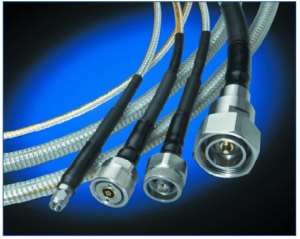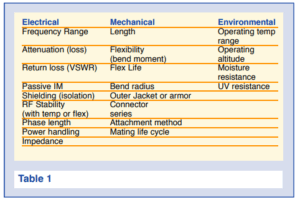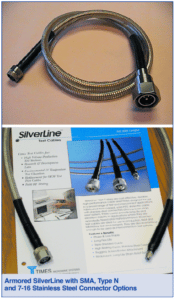How To Choose the Best Test Cable
by Paul Tusini, Times Microwave
Originally published in RF Globalnet
With so many choices, how does one decide on the appropriate test cables? Times Microwave introduces SilverLine Test cables, an all-around product designed for both production test and the lab and priced to provide exceptional value. This article examines cable and cable assembly mechanical and electrical performance characteristics and outlines a sound strategy for making the inevitable compromises typically required when choosing a product.
In May of 2004, a test engineer from a well-known company called Times with the following 50-ohm test cable requirements:
- Loss: <0.09db/ft @ 1 Ghz for 1 ft of cable (excluding SMA and N connectors)
- Minimum bend radius: 0.75” (1.5” bend diameter)
- Extremely flexible (low flex resistance or bending moment)
- 250,000, 180 degree flex cycles before degradation
- Good VSWR (“good” undefined)
- Maximum frequency of operation: 4 GHz
- High isolation (“high” not defined)
- Low cost
After summarizing the requirements, the customer added: “I don’t want anything that’s too difficult to make because I need them right away.” Unfortunately, this individual failed to recognize that many of these requirement’s conflict with each other to varying degrees, necessitating compromise in one or more areas. Understanding the balance manufacturers must strike when building high performance coax can aid one in specifying a product that is practical to build and thus cost effective. Since mechanical characteristics and RF performance are intertwined, it further helps to follow a pre-defined strategy for selecting the cable best suited for the application.
The above example is a good place to begin our discussion. With the development of various manufacturing techniques that reduce attenuation without increasing diameter, cable makers imply that the lower the loss, the better the product. While not necessarily true (more on this later), it should be recognized that some applications do indeed require attenuation levels not easily achieved with flexible RG coax. Still, regardless of the need, many seeking a quality test cable begin with a requirement for low loss as in this case.
Cable attenuation generally increases with frequency but decreases as the diameter grows larger. Attenuation can also be decreased by raising the velocity of propagation (Vp). Many flexible RG cables employ solid extruded PTFE ( Teflon™) as the dielectric. With a Vp of approximately 70% (that is, signals travel through it at a speed equal to about 70% of that through a vacuum), solid PTFE coax allows one to make a consistent, relatively low cost cable with properties that are well understood. Knowing we have connector losses to add to the equation and attempting to keep costs down by using RG coax, our customer’s attenuation requirement can only be met with a cable such as RG393 (0.390” O.D) or larger. Several issues become immediately apparent. First, a cable this size will be very stiff indeed. Further, as a rule of thumb, one should limit the bend radius to ten times the outside diameter in a constant flexing application. Depending on braid construction, frequency of operation and performance requirements, the minimum bend radius can occasionally be reduced to 5 times the outside diameter. Beyond this, one risks permanently changing (stretching, then kinking) the braids, altering performance. 3.9 inches (almost 7.8 inches diameter) is significantly outside the maximum limit imposed by the customer.

Second, RG393 is not well suited to SMA-sized connectors, making the attachment process more complex and perhaps yielding an unacceptable return loss. Finally, RG specifications do not call for particularly high shielding, so suppliers reduce the braid angle (that is, there is less wire contained in the braid per increment). While less wire generally equates to more flexibility, another affect is reduced flex life because the braids move and loosen more easily. A search of RG cable specifications eliminates any other candidates that won’t also require a significant compromise in at least one area.
We see above that increasing the cable diameter may be an unacceptable solution for achieving the desired attenuation. The next least costly method is to change the center conductor and/or outer braid construction. Specifying a solid center conductor improves loss 10-15% depending on the frequency. However, many solid center conductors are silver plated copper clad steel; not the best choice for flexibility. Keeping in mind the flex requirement in our example, a high strand-count silver plated copper center conductor would be called for, but this is not optimum for attenuation. A typical trade off is to replace the solid steel center conductor with more malleable (but solid) copper. Some of the flex life and flexibility of a stranded conductor is restored without negating the improvement in attenuation. Most popular RG cables use one or two layers of either tin or silver plated copper round wire braids for the outer conductor. When looking for improvements in outer conductors, manufacturers take their clues from copper jacketed semi-rigid cable. Ironically, for its core diameter semi-rigid is as low loss as as can be achieved using solid PTFE for the dielectric. Cable makers are constantly experimenting with new braid constructions and manufacturing methods in an attempt to achieve the ultimate flexible cable while mimicking the smooth, solid construction of copper jacketed semi-rigid cable.
A common strategy to improve overall performance including attenuation is to supplement a single round braid with a 50% overlay helical wrap as the inner layer over the core. While providing a surface more conducive to RF propagation, helical wraps have the added benefit of increasing a cable’s shielding (isolation). However, this structure also has a weakness. RF stability typically degrades more quickly with flexure. To help, many times a third, flat ribbon braid is added under the helical wrap. Applied against the dielectric, flat ribbon braids provide some of the smooth, regular surface of a helical wrap but hold up better under flexing. Individually or combined, flat ribbon and helical braid structures can improve attenuation up to 10%, depending on the frequency.
In summary, three-braid-layer cables provide improved attenuation, increased shielding and longer flex life, albeit at the expense of bending moment (stiffness). However, close attention to braid tension and angle (angles are typically defined by “pics” per inch, or the number of times the braid wires cross per increment) and tightly controlled processes result in cables that also transmit at much higher frequencies. They also maintain their RF performance with flexure much longer than RG cables depending on the frequency and the minimum bend radius required.
The most involved method of lowering attenuation includes not only the braid improvements and center conductor changes above but also changing the core construction. Expanded PTFE tape, foamed PTFE, spline PTFE and foamed polyethylene (PE) are all methods by which manufacturers increase the percentage of air in the dielectric, thereby decreasing its dielectric constant. More air generally translates into softer, more pliable core and therefore more flexibility. To maintain the proper impedance, larger center conductors are needed. A larger center conductor reduces resistance and helps achieve lower attenuation. It is not unusual to find low loss cables that exhibit Vp’s of 90% or higher. These cables are much lower in attenuation and sometimes even smaller in diameter and more flexible than the higher attenuation, solid PTFE alternative.
It would appear that low loss cable is the proper choice for our requirement above but again, there are trade-offs. The custom nature of low loss products makes using off-the-shelf connectors difficult at best and sometimes impossible. It is likely connectors designed solely for the selected cable might be the only choice, potentially lengthening lead times and raising costs. Low loss core can be slightly hygroscopic, absorbing flux or cleaning solutions. Some low loss cores don’t strip as cleanly as solid core. These issues can complicate the attachment process, further increasing costs.
The somewhat softer core can make achieving superior performance at higher frequencies consistently more difficult. For example, “dimpled” core from braids being applied too tightly will cause higher return loss. If the core is soft enough, braid components could move relative to each other more readily causing RF instability, particularly the phase or electrical length. The center conductor could move off- center and change the impedance (noticeable in some spline dielectric designs). Finally, low loss cable can potentially be more susceptible to damage from external physical pressure or other flexing dynamics. The higher the Vp, the more exacerbated are these issues. It may seem like low loss cable has too many problems to be considered, but in practice many of these issues might only be noticed at the very edge of the performance curve. Times LMR™, T-Flex™, SF™ and SFT™ series are prime examples of low loss and/or improved braid structure, high performance cables that squeeze the most from the loss budget yet provide excellent flexibility and high frequency performance.
Going back to our example, it becomes clear that a low loss cable may be required to meet or at least approach the loss budget but still meet the minimum bend radius/flexibility requirements. Trying to keep the customer’s price and delivery targets in mind, we first look at catalog products starting with PE dielectric technology….. Times LMR UltraFlex™ products. Because of its popularity in telecom and wireless, foamed PE cables and many connectors designed for it are readily available and very low cost. At 80-87% Vp foamed PE is also very low loss for its size. The UltraFlex™ series has a lower bending moment than standard LMR™ or generic foamed PE cables. A 0.200” diameter cable calculates out to be 0.12db of loss at the frequency of interest; very close to the customer’s requirement. While it appears we have the perfect solution, using our rule of thumb for minimum bend radius, this cable is too large in diameter.
Another product we consider is Times SFT316, but with a stranded center conductor. This is a 0.120” diameter, expanded tape wrapped PTFE cable with a 76% Vp. The softer PTFE core is more likely to meet the flexibility and flex life requirements and comes close to meeting the bend radius, but at 0.18db it is well above the loss budget. LMR is a two-layer product while SFT is a high isolation, three-layer product. Each uses a different core technology. Clearly achieving all the requirements in one product isn’t as easy as the customer anticipates.
Gaining the Best Performance and Most Value From a Test Cable
This example aside there are other aspects of a test cable that result in a superior product. Try to choose a connector series appropriately sized for the cable. One way to do this is to compare the cable center conductor diameter to the connector center contact diameter. Similarly sized components will have fewer transitions within the connector and at the attachment area, resulting in the best return loss.
Typically, the connector/cable attachment area is the first to fail so the strain relief system should provide for a smooth transition from a rigid attachment section to the flexible cable. A strain relief system that does not hold the attachment area immobile or creates a point of high leverage immediately behind it on the cable is ineffective and the assembly will fail prematurely. If possible, opt for solder attachment to both the braid structure and center contact for longest life and best electrical stability.
Unless the system or component under test has passive intermodulation considerations, the connectors should be machined from a quality stainless steel versus brass to achieve long life. Using steel increases the mating life cycle count and reduces metal wear and metal particles from being imbedded in the connector dielectric, changing the impedance of the connector. If possible, SMA series should have a thick wall outer conductor design to reduce crushing in the event a properly calibrated torque wrench is not used during mating.
Armoring a cable will help prevent damage from crushing, over-bending or kinking, but generally flexible armor will not prevent damage from torque….the most common reason for connector/cable attachment failure. Finally, the single most effective way to get the most value and longest life from your purchase is by training the user in proper handling, care and maintenance of the product.
A Strategy for Choosing a Suitable Test Cable

Our customer’s elusive goals precipitated several calls and emails over the course of about four weeks as the priorities on specifications and performance goals changed. This is not uncommon. It’s natural to want the best in all areas. Still, to make sense of it all, following a pre-defined strategy helps one quickly narrow the selection of both vendors and products. We’ll start by categorizing the more common parameters in Table 1.
This list is not meant to be all-inclusive. However, not every parameter need be considered for a test cable either. Further, many are linked to each other. For example, power handling decreases as altitude increases. If power is a prime consideration and the chosen cable’s maximum power handling is close to the minimum requirements, one may need to consider if the product will be used in high altitude areas vs. at sea level. A cable used largely outdoors will (or should) have moisture ingress considerations and perhaps require ultra-violet resistance. Moisture resistance affects both the choice of connector construction (internal and external sealing gaskets recommended) and cable (Times LMR-db water block braid construction recommended). UV resistance would require specific chemicals to be included in the jacket material. The final application will determine which ones to include.
First, from the list of the parameters, choose those that must be satisfied given the application. Next, set the minimum or maximum specifications limits. Certainly it makes sense to guard band the limits, but don’t go overboard. It causes needless expense and eliminates choices that might be perfectly suitable. Once this is accomplished prioritize the parameters from the most important to the least important, recognizing that those at the bottom of the priority list may need to be compromised.
Once this is accomplished identify the parameters and their min/max specification limits that are desirable but not absolutely required, and prioritize these as well. Why do this if the “must” list has been identified? Because it makes clear not only that for which you are willing to pay extra but just as importantly, that for which you are unwilling to pay extra.
Consideration of the most suitable cable technology is the first step towards narrowing the vendor base. With a little research, determine which technology best meets the “must” category of parameters and goals. In our example, if a 250,000 flex life is a high priority “must,” then vendors best known for semi-rigid coax probably aren’t going to offer many choices. This technology and the vendors that specialize in it can be eliminated. Larger vendors like Times make cable using more than one technology or material like solid and foamed PE, solid and tape wrapped PTFE and now even silicon dioxide, and therefore offer many more choices under one roof.
In conclusion, remain realistic. Keep in mind that generally, the more top-priority parameters which one insists be included and the more stringent the specification the more exhaustive the search will tend to be and more costly and/or longer lead time the item.

In the example used throughout this article, this customer insisted attenuation, bend radius and flex life all had to be the absolute best modern technology had to offer. While these were important, an examination of critical needs revealed that the attenuation for a one-foot long cable at 1 ghz was not substantially more in solid PTFE than low loss core and the flex life need not be nearly so high or the bend radius so tight. Also revealed was that electrical stability with flexure, a parameter most often overlooked, was paramount and that the typical failure mode of the existing cable was that the connectors broke off before the cable wore out from flexure. SilverLine test cables met the customer’s true needs, addressed the typical failure mode, fell well within budget constraints and were in stock for immediate delivery. Today SilverLine test cables are used throughout this customer’s test and repair facility in various configurations and lengths.
Contact Times or your local, authorized Times distributor for more information on SilverLine® Test Cables.
Subscribe to our newsletter!
Interested in receiving email newsletters and other updates from Times? Subscribe now!
